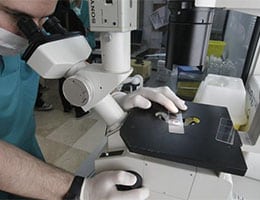 A microorganism is a tiny organism that can only be observed through a microscope . It is a single-celled living being that can also be mentioned as a microbe , a term that derives from the French microbe .
A microorganism is a tiny organism that can only be observed through a microscope . It is a single-celled living being that can also be mentioned as a microbe , a term that derives from the French microbe .
The human eye cannot see microorganisms with the naked eye. The only way to detect these beings is by using a microscope, which is an instrument created precisely for the observation of very small elements.
Robert Hooke y Antonie van Leeuwenhoek están entre los científicos que, en el 17th century, realizaron las primeras observaciones de microorganismos gracias al uso de microscopios. Así, con los años, se logró descubrir cómo la leche se transforma en cheese y cómo la uva permite obtener came, por ejemplo.
Leeuwenhoek is praised for his discoveries in the field of microbiology. He was born in 1632 and was a Dutch merchant who not only was ahead of the rest in the use of the microscope , but also improved his manufacturing techniques. Hooke, for his part, was a contemporary scientist, born in England and interested in several fields, including medicine and biology.
In 1665, Hooke published a book titled Micrographia , in which he described his observations through the microscope and coined the term cell , fundamental in science today. Returning to the phenomena that allow grapes to be transformed into wine and milk into cheese, it is important to note that before Leeuwenhoek discovered microorganisms, it was not known why they occurred, nor was it understood why food products spoiled.
Of course, Leeuwenhoek's work was not enough to explain all the concepts that are part of scientific knowledge today; In particular, he pointed out that there were life forms too small to be seen with the naked eye . Other important names on this path of discoveries about microorganisms were Lazzaro Spallanzani and Louis Pasteur , who put an end to the idea that life arose from dead substances spontaneously in the midst of deterioration.
Spallanzani, an Italian naturalist and religious born in 1729, discovered that by boiling a culture broth he could sterilize it, that is, kill the microorganisms found in it. Furthermore, he understood that for other microorganisms to settle, he had to expose the broth to air. The French chemist Pasteur, born in 1822, complemented these discoveries by exposing broths to air, covering the containers with filters to prevent them from mixing with external particles and also using containers with curved tubes that prevented contact of the broth with the dust. Through his experiments he reinforced the idea that living organisms did not appear spontaneously, but rather came from outside.
 Bacteria are microorganisms, as are certain fungi . They are also acellular entities like viruses . Microbiology is the scientific specialty that is responsible for its study.
Bacteria are microorganisms, as are certain fungi . They are also acellular entities like viruses . Microbiology is the scientific specialty that is responsible for its study.
Although there are microorganisms that are pathogenic (that is, they cause disease ), most microbes are not harmful to humans. In fact, many microorganisms play an important role in being responsible for the decomposition of organic matter and even providing oxygen to the atmosphere.
As for pathogenic microorganisms, they are those that have the ability to enter the body and multiply in it, generating an infection . Many infectious diseases are contagious: the affected person can spread it through their mucous membranes, skin or secretions.
The flu or influenza , to cite one case, is an infectious disease caused by influenza viruses. These microorganisms, once they infect the subject, can cause headache, myalgia , sore throat, cough and fever, among other inconveniences.
